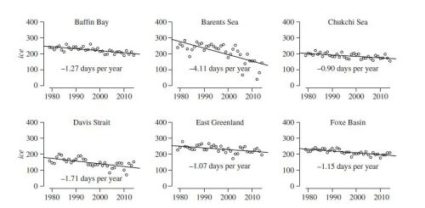In case you missed it — or missed the significance of it — polar bear specialist Mitch Taylor correctly pointed out in his recent essay (a response to the New York Times article that appeared Tuesday (10 April) about the Harvey et al. (2018) BioScience paper) that the International Union for Conservation of Nature Polar Bear Specialist Group (IUCN PBSG) have given up using computer models of future sea ice extent based on rising CO2 levels supported by the IPCC.
Their latest assessment (Regehr et al. 2016) does not link polar bear survival models to climate modeled forecasts of Arctic sea ice decline but rather to an assumption that declines already documented will continue in a linear fashion over this century.
This means that CO2 emissions blamed on human fossil fuel use is no longer directly tied to the predicted future decline of polar bear numbers: IUCN polar bear specialists simply assume that sea ice will continue to decline in a linear fashion with no cause attributed to that decline except the broad assumption that anthropogenic climate change is to blame for Arctic sea ice declines since 1979.
No wonder former USGS polar bear biologist Steve Amstrup never refers to this IUCN PBSG study: he and the organization that now employs him, Polar Bears International, are still firmly wedded to the concept that CO2 is the sea-ice control knob.
Mitch said last month, in part:
“It is also germane that the IUCN Redbook authority was unwilling to continue listing polar bears as a “vulnerable” species based on current population estimates and Amstrup’s Bayesian Network model expectations. This was somehow not mentioned in the article criticizing Susan. Polar bears remain an IUCN “vulnerable” species, but now that is based on a Polar Bear Specialist Group (PBSG) polar bear population model that is also driven by speculation and also presented as “expert” predictive.
The new model [Regehr et al. 2016] guarantees that polar bears will decline by decoupling the model’s population projections from climate model forecasts of sea ice conditions … and just using the time-series regression of sea ice decline since 1980 to forecast sea ice (index for polar bear carrying capacity) forward.1
And the IUCN went for it.
There is an International Agreement for the Conservation of Polar Bears, and occasionally the parties to that Agreement (USA, Canada, Denmark-Greenland, Norway, and Russia) have formal meetings. The signatory nations (parties) take their information only from the IUCN/SSC Polar Bear Specialists Group (PBSG)….”
Footnote 1. “By de-coupling I meant that Regehr’s model [Regehr et al. 2016] has no input from the GCMs [General Circulation Models] for sea ice dynamics. If you suddenly reduced CO2 levels somehow, the GCMs would respond by predicting an increase in sea ice. Regehr’s model uses a simple regression fit to sea ice decline as measured since the satellite record began in 1979. As you know, sea ice declined faster than the GCMs predicted. So the PBSG has have given up on the climate models and now they just use the historical slope to project continued sea ice decline forward. In other words, their current argument for up-listing polar bears due to anthropogenic global warming is now entirely independent of atmospheric CO2 levels. 🙂 It seems the PBSG agrees that climate models are not predictive with respect to sea ice which was their central argument for up-listing them in the first place.”
Mitch is spot-on in pointing out that the IUCN Red List assessment for 2015 did not use General Circulation Model (GCM) sea ice predictions based on atmospheric CO2 levels for their polar bear survival models (as did Amstrup and colleagues in 2007), which means that predicted polar bear declines accepted by the IUCN are no longer linked to increasing levels of CO2 as a causative agent.
This information was buried in the supplemental data but is stated clearly: see the quote below from the Regehr et al. (2016) supplementary data, page 7 (pdf here):
“We projected *ice* forward using linear models fitted to observed values of the metric from 1979-2014, rather than recalculating the metric based on forecasts of sea-ice extent from global climate models. Summer sea-ice loss based on linear projections is generally more rapid than projections based on the ensemble mean of Coupled Model Intercomparison Project Phase 5 (CMIP5) models through mid-century [11, 12], although we did not evaluate how global climate model output would compare to observed values of the metric *ice*.”
In other words, the PBSG researchers admit that predicted ice loss has been less than what has been observed (as I’ve pointed out many times, see Crockford 2017, 2018, Crockford and Geist 2018) and assume their “linear” approach (simply extending the slope of the lines describing recent declines, as shown below in part of Fig 2 from their paper, into future decades) will better predict future conditions than complex climate models based on rising CO2 levels.
Note also their assumption of a linear decline in sea ice coverage over coming decades is not based on any complex analysis of sea ice: it simply assumes that what has happened to sea ice since 1979, region by region, will continue for at least the next 30 years without any consideration of what happened before.
Quite astonishing, really.
Dr. Mitch Taylor was a member of the IUCN PBSG as a polar bear scientist representing Canada for 28 years (1981-2008) but in 2009 he was booted out by chairman Andrew Derocher for his skeptical views on human-caused global warming. The group then changed their rules on membership to justify their actions. Mitch currently teaches at Lakehead University, is still active in polar bear research and still writes peer-reviewed papers and professional reports on that research (e.g. Anderson et al. 2016; York et al. 2016).
Read more at Polar Bear Specialist



















Polar Bears are Not Endangered listing them on the ESA was pure propeganda do the EcoWackos could use them as their mascots for their idiotic campiagns aimed at school kids